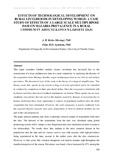| dc.contributor.author | Musingi, JK | |
| dc.contributor.author | Ayiemba, EHO | |
| dc.date.accessioned | 2013-06-20T13:07:39Z | |
| dc.date.available | 2013-06-20T13:07:39Z | |
| dc.date.issued | 2012 | |
| dc.identifier.citation | Musingi, JK, Ayiemba EHO. 2012. Effects of Technological Development on Rural Livelihoods in Developing World: A case Study of Effects of a Large Scale Multipurpose Dam on Malaria Prevalence in a Rural Community around Kenya’s Largest Dam. European Scientific Journal. Vol. 8, No. 14(June, 2012):132-143. | en |
| dc.identifier.uri | http://erepository.uonbi.ac.ke:8080/xmlui/handle/123456789/36861 | |
| dc.description.abstract | This paper examines whether malaria disease prevalence has increased due to the construction of a large multipurpose dam in a rural community by analyzing the distance of the respondents from Masinga dam(the largest multipurpose dam in east Africa) and malaria prevalence. The theoretical basis of the study is the theory of ecological simplification. This theory asserts that, species in any natural ecology tend to be specialized and to be controlled in numbers by competition in their specialized niches. Once the ecosystem is interfered with by human activities, the control feedback mechanisms are broken. Those species (in our case, anopheles mosquitoes) that can survive the impacts caused by changes in ecosystem due to human interference have more opportunity to explode in population numbers since the niche competition has been eliminated. Moreover, the rural community is poorly cushioned from the expected diseases increase since prior preparations in form of medical facilities are not part of the dam preparation.
The paper analyses primary data from a randomly selected sample of respondents from near the dam. The distance of the respondents from the dam was calculated using global positioning system (GPS). Simple Linear Regression and cross tabulation are done to analyze for relationships. The results show that, malaria is the most common disease in the populations near the dam and the disease used to vary with seasons, with high prevalence being experienced in the rainy seasons in the earlier years after the dam construction. However, in later years, this variation disappears and malaria remains high throughout the months irrespective of the season. Prevalence was found to have increased by 47% among the local rural population. The increase in malaria prevalence can only be attributed to the presence of the dam because this occurrence decreases as we move away from the dam. The paper, further, presents the results to show a spatial relationship of malaria occurrence that can be used for planning intervention measures to reduce the disease in the study area and prevent the disease from devastating impacts on the poor rural community near the dam. | |
| dc.language.iso | en | en |
| dc.title | Effects of Technological Development on Rural Livelihoods in Developing World: A case Study of Effects of a Large Scale Multipurpose Dam on Malaria Prevalence in a Rural Community around Kenya’s Largest Dam | en |
| dc.type | Article | en |
| local.publisher | College of Humanities and Social Sciences, University of Nairobi | en |

